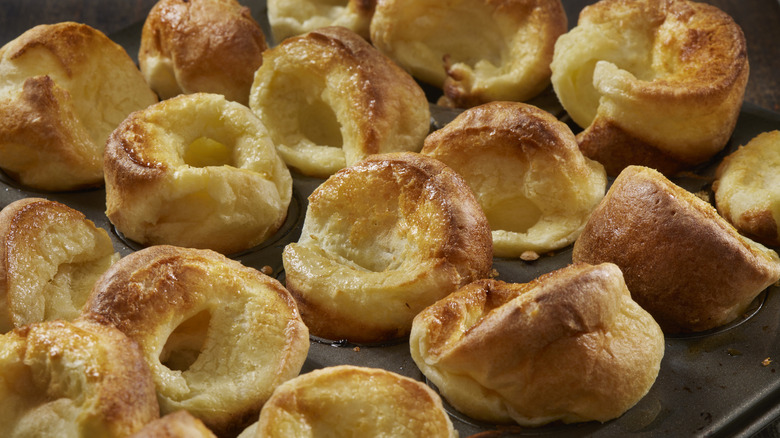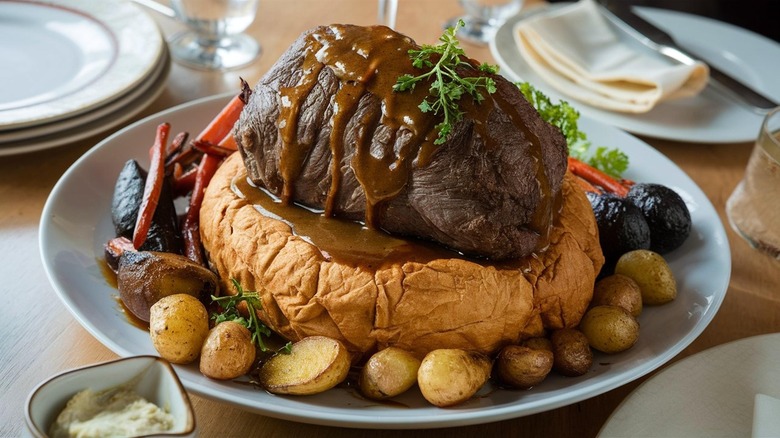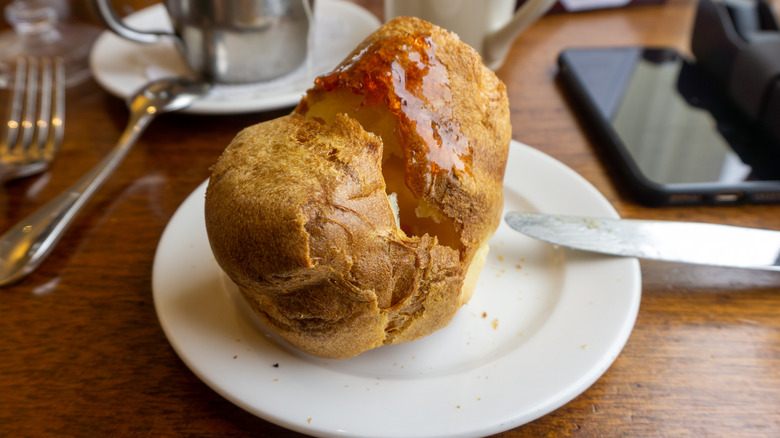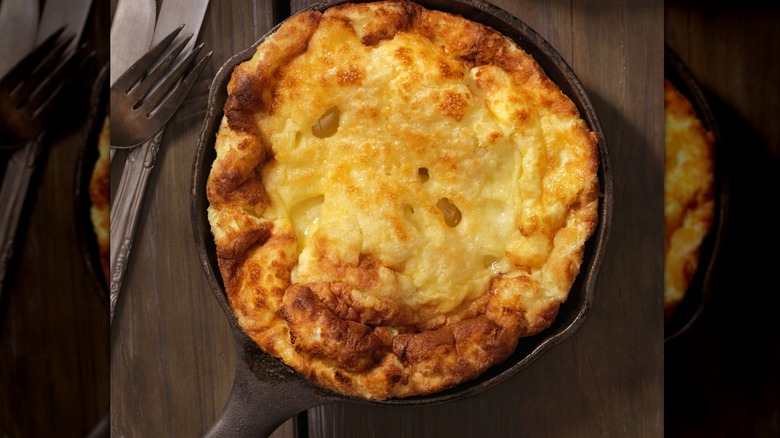What Sets Yorkshire Pudding Apart From Popovers?
We may receive a commission on purchases made from links.
They start off with the same batter (eggs, flour, and milk), are both browned and crispy on the outside and eggy and airy inside, are similarly inconsistent in shape, and are delicious accompaniments to almost any meal. But there are enough subtle differences between Yorkshire pudding and popovers, starting with their country of origin, the tins used to bake them, and the fat used to grease their pans, to make an American or Brit balk at the idea that they are one in the same.
What Yorkshire puddings and popovers share are their distinctive golden crusts and light and fluffy characteristics. In both cases, the batter is beaten vigorously to create tiny air pockets that end up trapped by the gluten in the flour and the protein of the eggs. The batter is then poured into a well-oiled pan and placed in an oven set at a high temperature — 425 to 450 degrees Fahrenheit. At that heat, the air bubbles in the batter coalesce and, because of the batter's high liquid-to-flour ratio, steam builds up and causes the top of the crust to rise, creating that distinctive airy interior. With popovers, the crust filled with that air pocket flips over the top, giving the pastry its name.
What is Yorkshire pudding?
The first thing to know about Yorkshire pudding is that it is not anything like what Americans call pudding. In the United States, pudding usually refers to a creamy, custardy dessert, while in the United Kingdom, it is an overarching term for dishes typically boiled or steamed. They can be sweet, like spotted dick or sticky toffee pudding, or savory, like blood pudding. Yorkshire pudding, a pastry with a light, golden, crispy crust that opens to a steamy, eggy pocket of air, falls into the latter category since it is usually topped or filled with savory meats and gravy.
Commonly associated with Northern England, the dish was likely created in the mid-18th century. It was often made in an open fire beneath roasting meat, allowing it to capture the rich, warm fat drippings, an important energy source for those in the part of England where it was a struggle to afford meat. Traditionally, it was served with gravy as an appetizer to fill people up so they would eat less of the more expensive main course. In fact, Britain's Royal Society of Chemists' (RSC) says this is still the only way to serve Yorkshire pudding (via BBC).
Today, Yorkshire pudding is made in a separate pan greased with meat drippings or beef fat. This gives it a more savory flavor and a slightly denser texture than buttery, flaky popovers. To the dismay of the RSC, the pudding is regularly served as an entree. The classic English dish toad in the hole is a large Yorkshire pudding filled with sausages and topped with onion gravy. Additionally, entire meals — including meat, vegetables, and potatoes — are often served on top of a large Yorkshire pudding.
What are popovers?
A popover is considered the American version of Yorkshire pudding. Similarly, it is a thin-crusted airy pastry with an eggy interior, although it's not typically made with meat drippings. While there is no well-documented history of when cooks first started making popovers in the U.S., the first mention of them in cookbooks was in 1876. Popovers are generally enjoyed any time of day. For breakfast, they can be buttered and layered with jams and jellies. For brunch or lunch, they can be filled with smoked salmon and scrambled eggs. And, for dinner, they can be served alongside any savory dish and dipped into gravy.
Instead of lining the pan with beef fat as you would for Yorkshire pudding, the pan for popovers is either greased with butter or melted butter is poured into the bottom of individual tins. Sometimes the butter is incorporated into the batter. Whichever method is used, the butter gives popovers a flavor somewhat distinctive from that of Yorkshire pudding as well as a flakier texture.
Specialized pans make for different shapes and sizes
Home cooks can and often do use muffin tins to make both Yorkshire puddings and popovers. However, professional bakers use specialized pans that give a more distinctive look to each. Popover pans, like this non-stick option from Chicago Metallic, are narrower, deeper, and more cylindrical than a muffin tin. The design helps apply heat directly to the moist batter, building the steam needed to create the billowy, airy top that gives popovers their name and leaving them with more space to rise.
If you never knew why you needed a muffin top tin, like this pan from Wilton, a shallower version of a muffin tin that's an uncommon but useful kitchen tool, you'd find the answer in Yorkshire pudding. This specialized pan helps ensure you get a proper rise for your pudding, which is important given that the RSC has guidelines stating Yorkshire pudding must be at least 4 inches tall, per BBC. Another option — and the more traditional one — is to cook a Yorkshire pudding in one large, shallow pan, like a cast iron skillet, and cut it into individual servings.



